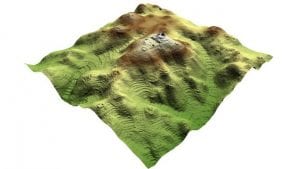Lidar archaeology shines a light on hidden sites
UCF Anthropologists Arlen and Diane Chase have been gaining international attention for their use of lidar archaeology. The British Broadcasting Corporation (BBC) recently featured the Chases in a piece about lidar archaeology. You can read an excerpt below and view the full article by clicking here.
If you think archaeologists spend all the time with trowel in hand in a muddy ditch then it’s time to think again. More and more are using sophisticated aircraft-mounted lasers, and it is opening up a new age of discovery.
For the best part of 25 years, archaeologists Arlen and Diane Chase slogged through the thick undergrowth in the west of Belize in search of an ancient city whose details had been lost to the passage of time and the decay of the jungle.
The going was tough, often requiring a machete to clear a path through the dense vines and creepers that blocked their way. Over time, their perseverance paid off as their hand-drawn maps began to reveal long-forgotten parts of the massive Mayan city of Caracol.
But the more the pair found, the more they realized the extent of what remained uncovered. It would take several lifetimes, they figured, to reveal the true extent of Caracol.
Then, in 2008, they got talking to a biologist colleague at the University of Central Florida where they worked. For years, he had been using airborne laser sensors known as Lidar (Light Detection And Ranging) to map and study forests and other vegetation. He suggested they give it a go.
Read more from the BBC about the Chases by clicking here.

